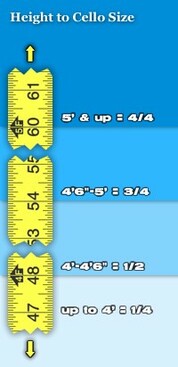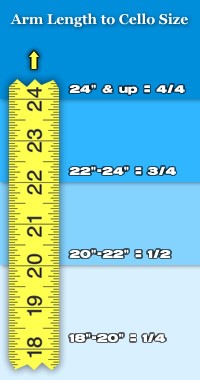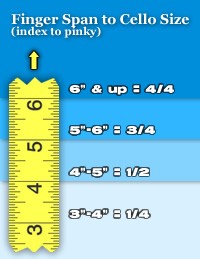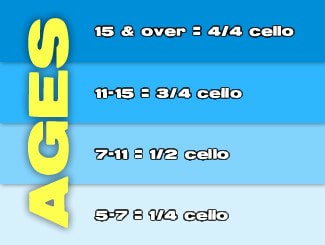CELLO SIZES
How to Determine the Right Cello Size
About cello sizesCellos are made in many different sizes, with the 4/4 (full size), 3/4, 1/2, and 1/4 sizes being the most common. Most adults play the 4/4 cello, though a 7/8 size does exist for adults who have a hard time playing the full sized instrument.
Please note that this information is provided as a free service and without warranty or liability. There are different methods of sizing a cello, so if your teacher has a recommendation, you should follow your teacher's advice.
Tips When Trying Out a Cello
When trying out a cello, be sure to
How to measure (using a cello)If you have access to cellos of different sizes, it is recommended that you follow this process to determine which cello is right for you.
How to measure (without a cello)You can achieve a very close approximation using three measurements.
Cello measurement charts
How to Determine the Right Cello Size
- About cello sizes
- How to measure (using a cello)
- How to measure (without a cello)
- Cello measurement chart
- Using age to determine size
About cello sizesCellos are made in many different sizes, with the 4/4 (full size), 3/4, 1/2, and 1/4 sizes being the most common. Most adults play the 4/4 cello, though a 7/8 size does exist for adults who have a hard time playing the full sized instrument.
Please note that this information is provided as a free service and without warranty or liability. There are different methods of sizing a cello, so if your teacher has a recommendation, you should follow your teacher's advice.
Tips When Trying Out a Cello
When trying out a cello, be sure to
- Sit up straight with good posture.
- Sit on a chair that is a comfortable height — not too low or too high.
- Plant feet firmly on the floor with the cello between your knees.
- Extend the endpin to a length that will bring the bottom of the bouts (the rounded edges of the lower half of the cello) to where they touch the insides of the knees. Then see if the pegs are at the height of the left ear.
- If the cello feels too large and the fingers overextending in first position, choose the smaller size.
How to measure (using a cello)If you have access to cellos of different sizes, it is recommended that you follow this process to determine which cello is right for you.
- Sit with your knees bent at 90 degree angles
- Hold the cello and check for the following:
- The upper rim of the cello should rest on the sternum (breast bone)
- The lower bout corner should be touching the left knee
- The neck of the cello should be a few inches away from the left shoulder
- The C string (thickest string) peg should be near the left ear
How to measure (without a cello)You can achieve a very close approximation using three measurements.
- The height of the player
- The distance from the shoulder socket to the tip of the middle finger (left arm)
- The distance between the tip of the index finger and the tip of the pinky (left hand)
Cello measurement charts
- The height of the player
2. The distance from the shoulder socket to the tip of the middle finger (left arm)
3. The distance (SPREAD) between the tip of the index finger and the tip of the pinky (left hand)
Using age to determine size
If you do not have access to an instrument and measurements are not available, you can approximate the cello size by using a child's age. This is not the most accurate system, as some children will be large or small for their age. This chart is intended to give you a general idea only.
If you do not have access to an instrument and measurements are not available, you can approximate the cello size by using a child's age. This is not the most accurate system, as some children will be large or small for their age. This chart is intended to give you a general idea only.
EDITED BY FLAVIO LIVIO CIANFLONE www.themusicchord.com



